Quick Look
Grade Level: 7 (6-8)
Time Required: 45 minutes
Expendable Cost/Group: US $10.00 $10 is enough to create the boxes. Additional non-expendable (reusable) items are required, such as one or more web cameras and computers; see the Materials List for details.
Group Size: 4
Activity Dependency:
Subject Areas: Science and Technology
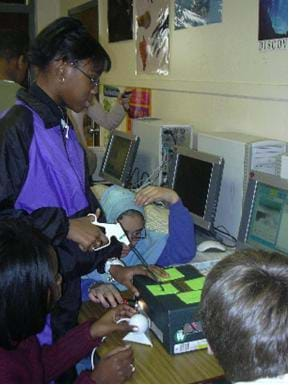
Summary
Students act as surgical residents for the day. Working in teams, they use surgical instruments to complete tasks that are inside of a box, hidden from direct view. They are able to see inside of the box with the help of a "laparoscope" (webcam and flashlight). This engaging activity shows students one application of engineered medical instrumentation and gives them first-hand experience in seeing how form fits function. They also learn that an engineer's job does not end with a finished product because s/he must train others to use the device correctly.Engineering Connection
Engineers work with physicians to design and test creative new tools for medical applications. This activity looks at how new technology developed by engineers is changing surgery by reducing the number of invasive procedures.
Learning Objectives
After the activity, students should be able to:
- Describe how surgeons are trained to use medical devices created by engineers.
- Define laparascopic surgery.
- Explain why laparascopic surgery is better for patients than other more invasive surgical techniques.
Educational Standards
Each TeachEngineering lesson or activity is correlated to one or more K-12 science,
technology, engineering or math (STEM) educational standards.
All 100,000+ K-12 STEM standards covered in TeachEngineering are collected, maintained and packaged by the Achievement Standards Network (ASN),
a project of D2L (www.achievementstandards.org).
In the ASN, standards are hierarchically structured: first by source; e.g., by state; within source by type; e.g., science or mathematics;
within type by subtype, then by grade, etc.
Each TeachEngineering lesson or activity is correlated to one or more K-12 science, technology, engineering or math (STEM) educational standards.
All 100,000+ K-12 STEM standards covered in TeachEngineering are collected, maintained and packaged by the Achievement Standards Network (ASN), a project of D2L (www.achievementstandards.org).
In the ASN, standards are hierarchically structured: first by source; e.g., by state; within source by type; e.g., science or mathematics; within type by subtype, then by grade, etc.
NGSS: Next Generation Science Standards - Science
-
Models can be used to represent systems and their interactions.
(Grades 6 - 8)
More Details
Do you agree with this alignment?
-
Small changes in one part of a system might cause large changes in another part.
(Grades 6 - 8)
More Details
Do you agree with this alignment?
-
The uses of technologies and any limitations on their use are driven by individual or societal needs, desires, and values; by the findings of scientific research; and by differences in such factors as climate, natural resources, and economic conditions.
(Grades 6 - 8)
More Details
Do you agree with this alignment?
International Technology and Engineering Educators Association - Technology
-
Students will develop an understanding of and be able to select and use medical technologies.
(Grades
K -
12)
More Details
Do you agree with this alignment?
-
Advances and innovations in medical technologies are used to improve healthcare.
(Grades
6 -
8)
More Details
Do you agree with this alignment?
-
Differentiate between inputs, processes, outputs, and feedback in technological systems.
(Grades
6 -
8)
More Details
Do you agree with this alignment?
-
Develop innovative products and systems that solve problems and extend capabilities based on individual or collective needs and wants.
(Grades
6 -
8)
More Details
Do you agree with this alignment?
State Standards
North Carolina - Math
-
Use appropriate tools strategically.
(Grades
K -
12)
More Details
Do you agree with this alignment?
Materials List
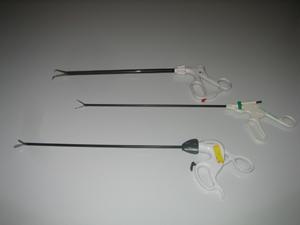
- cardboard shoe box, one per group
- foam sheets
- scissors
- glue
- flashlight
- stopwatch
- laparoscopic surgical tools, or some other kind of tool(s) to manipulate inside each box; obtain real laparoscopic devices from a manufacturer or local hospital; if actual instruments are not available or donated, use kitchen tongs and enlarge the box and adjust the task to accomodate the tongs size; or use chop sticks attached with rubber bands at one end; or use pliers
- some way to record live video inside each box and view it in real-time on a screen, such as a web camera and a computer, or a digital camera that works like a web camera, or a video camera and a TV
- assorted materials needed to conduct various manipulative tasks inside each box, such as pom-poms, beans, cups, nails, hooks, rings, beads, little plastic toys, Velcro pieces, string, etc. (see the Procedure section)
- Laparoscopic Surgery Worksheet, one per student
Worksheets and Attachments
Visit [www.teachengineering.org/activities/view/duk_surgicaldevices_tech_act] to print or download.Pre-Req Knowledge
Familiarity with the basic concept of laparoscopic surgery, as presented in the associated lesson, Medical Instrumentation.
Introduction/Motivation
Who in this class has had some kind of surgery? For those of you who do not mind sharing a little bit about your surgery, what size of a scar do you have? How do you think the surgeons performed the surgery making such a small incision?
Laparoscopic surgery reduces the potential for scarring and infection because it is a minimally invasive surgery. A small incision is made in the abdomen, and the entire abdominal cavity is inflated with carbon dioxide. Two or three other holes, or ports, are made, and surgery is performed using specialized tools that are inserted through these ports. The instruments used in these kinds of procedures are very skinny so that they can fit through the ports. They are also fairly long so that the handle of the instrument can be outside of the body, while the other end is inside of the body. The ends of these instruments are specially designed for a multitude of uses. They can cut, grasp, clamp and staple, just to name a few uses. Like the other laparoscopic instruments, the laparoscope is long and skinny to fit its function.
How does a surgeon see what he or she is doing? A special camera called a laparoscope is also inserted through one of the ports. It has a light source and lens on the end that is inserted into the body. Fiber optics in the scope act as light pipes to send light into the body and carry the image out to a television screen.
In order to complete the delicate tasks required, surgeons must be extremely proficient with the instruments that they use. Training sessions similar to the activity that follows can provide a means of becoming adept at this task. Practice, practice, practice!
Procedure
Before the Activity
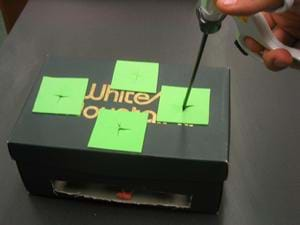
- Gather materials and make copies of the Laparoscopic Surgery Worksheet.
- Make several test stations, each consisting of a computer, webcam, training box, flashlight, stopwatch, and one or two laparoscopic graspers. Any type of webcam can be used. Remember, it may be necessary to install a driver to use some types of cameras; check the documentation provided with the camera. Obtain laparoscopic graspers at a local hospital or by contacting a biomedical company. Kitchen tongs, chop sticks or regular pliers may be substituted for laparoscopic graspers. A video camera and TV may substituted for the web camera and computer.
- Follow the instructions below to prepare training boxes.
To create a training box:
- Use scissors to cut four circular holes in the shoe box lid and four rectangular holes in each box side. Make the circles ~5 cm (2 inches) in diameter. Make the rectangles run the length of the sides of the box, leaving about 5 cm (2 inches) on either side. They should be large enough for both the head of the flashlight and the webcam lens to fit through.
- Next, cut eight squares of foam that are each 5-8 cm (2-3 inches) on each side. These should be large enough to cover the circular holes in the top of the shoe box. Stack two squares, and cut two perpendicular slits from left to right and top to bottom. Repeat for the other 6 foam squares. Glue one of the foam squares over the top of each circular hole, and one on the bottom of each hole. The slits allow the instruments to enter the box while preventing students from seeing inside the box (like skin on a body; see Figure 1).
- For each box, formulate a task that may be accomplished using the graspers (or available tools) while students watch via a camera placed on the side of the box. This set-up is the "surgery." Real surgeons are trained this way. Example tasks:
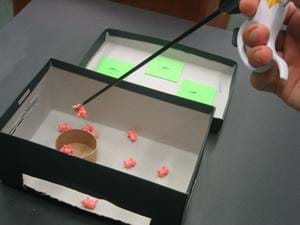
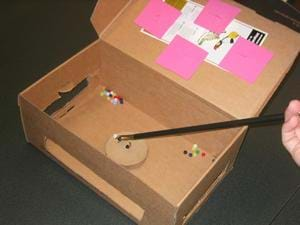
- Transfer pom-poms or beans from one container to another.
- Pick up small plastic toy pigs and place them in the "pig pen" (see Figure 2).
- Attach Velcro pieces.
- Pick up small rings or beads and place them over nails or hooks (see Figure 3).
- Use two instruments to tie a knot in a piece of string. (This is a very difficult task.)
With the Students
- Divide the class into groups of three or four students each. Students work in teams to complete the task inside a training box.
- Hand out the worksheets and let students view inside each box. The worksheet provides procedures, instructions and data tables to guide the activity.
- One student holds a flashlight, another maneuvers the webcam, and a third manipulates objects using the graspers. To successfully accomplish a task, a team must communicate well. If a group has a fourth member, s/he can be in charge of the stopwatch. Another option for extra students is to play the role of surgical patients by lying on the table, holding the box on their stomaches. A little bit of patient movement makes the "surgery" more challenging.
- If desired, students can record the time it takes them to complete each task and compete for the fastest times. Record times on the worksheets.
- Have students answer the worksheet questions and turn them in for grading.
- Conclude by leading a class discussion to review results and conclusions and ask the questions in the Assessment section.
Vocabulary/Definitions
biomedical engineering: A discipline of engineering that applies engineering concepts to biology, physiology and medicine.
fiber optics: Long strands of solid glass that transmit light signals from one location to another.
laparoscope: A thin surgical camera that can be inserted into the body through a very small incision. With this tool, images from inside the body can be viewed on a video screen.
Assessment
Concluding Discussion: At activity end, lead a wrap-up discussion. Ask the students:
- What made these seemingly simple tasks so difficult?
- Do you think that a surgeon is immediately proficient at this type of procedure?
- How are surgeons trained to perform laparoscopic surgery?
- Describe how the form of the laparoscopic graspers fit their function?
- Why is laparoscopic surgery better for the patient than earlier surgical methods?
- How are engineers involved in the creation of surgical tools?
- How would a real surgery be different between our set-up?
Troubleshooting Tips
Check all of the webcams and computers before class starts.
Try each task to make sure it is not too difficult to accomplish. It is good to have some tasks that are easier and others that are harder.
Groups of three or four students each work best. If groups are larger, some students become bored.
Activity Scaling
- Adjust the difficulty of the challenge tasks inside the boxes so they are suitable for your students.
- Set up one box with a very difficult task, so that more proficient students are kept engaged.
Subscribe
Get the inside scoop on all things TeachEngineering such as new site features, curriculum updates, video releases, and more by signing up for our newsletter!More Curriculum Like This

Students are introduced to the abdominopelvic cavity—a region of the body that is the focus of laparoscopic surgery—as well as the benefits and drawbacks of laparoscopic surgery.

Students learn about the sorts of devices designed by biomedical engineers and the many other engineering specialties that are required in their design of medical diagnostics, therapeutic aids, surgical devices and procedures, and replacement parts. They discuss the special considerations that must ...

Students teams use a laparoscopic surgical trainer to perform simple laparoscopic surgery tasks (dissections, sutures) using laparoscopic tools. Just like in the operating room, where the purpose is to perform surgery carefully and quickly to minimize patient trauma, students' surgery time and mista...

Student teams create laparoscopic surgical robots designed to reduce the invasiveness of diagnosing endometriosis and investigate how the disease forms and spreads. Using a synthetic abdominal cavity simulator, students test and iterate their remotely controlled, camera-toting prototype devices, whi...
References
Laparoscopic Trainer, Created by Dane Arends, Coordinator of the Animal Surgical Research Unit, Summa Health System – Akron City Hospital, Department of Surgical Research
Copyright
© 2013 by Regents of the University of Colorado; original © 2004 Duke UniversityContributors
Emily McDowellSupporting Program
Techtronics Program, Pratt School of Engineering, Duke UniversityAcknowledgements
This content was developed by the MUSIC (Math Understanding through Science Integrated with Curriculum) Program in the Pratt School of Engineering at Duke University under National Science Foundation GK-12 grant no. DGE 0338262. However, these contents do not necessarily represent the policies of the NSF, and you should not assume endorsement by the federal government.
Last modified: June 3, 2019










User Comments & Tips